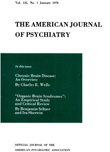Hyperventilation Leading to Hallucinations
Abstract
The authors present two cases in which hyperventilation repeatedly led to hallucinations. They consider possible mechanisms and discuss their implications for the understanding of hallucinatory phenomena in schizophrenics, normals, and members of primitive societies. Four factors may be significant in determining whether hallucinatory phenomena will occur and in which sensory modalities: 1) the neurological integration of the individual; 2) the cerebral-vascular reactivity and pattern; 3) local cerebral requirements for oxygen and the capacity for extraction of it; and 4) the respiratory rate and buildup in hyperventilation.
Access content
To read the fulltext, please use one of the options below to sign in or purchase access.- Personal login
- Institutional Login
- Sign in via OpenAthens
- Register for access
-
Please login/register if you wish to pair your device and check access availability.
Not a subscriber?
PsychiatryOnline subscription options offer access to the DSM-5 library, books, journals, CME, and patient resources. This all-in-one virtual library provides psychiatrists and mental health professionals with key resources for diagnosis, treatment, research, and professional development.
Need more help? PsychiatryOnline Customer Service may be reached by emailing [email protected] or by calling 800-368-5777 (in the U.S.) or 703-907-7322 (outside the U.S.).



